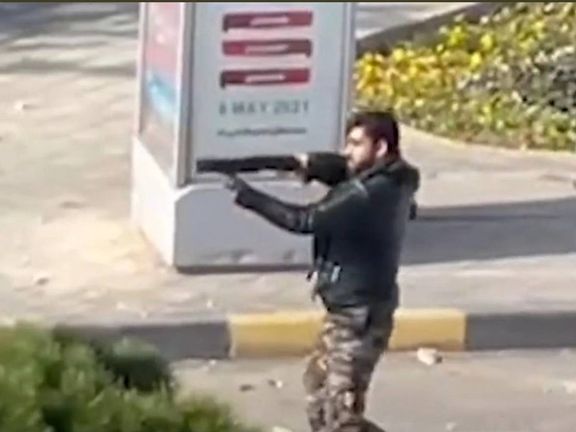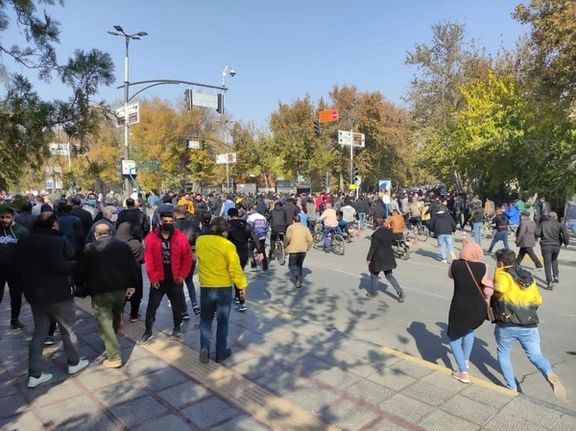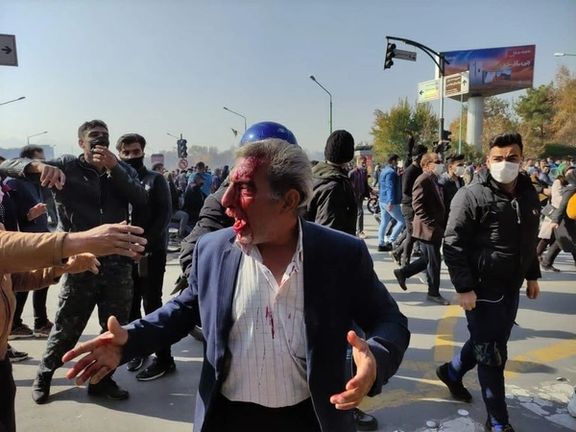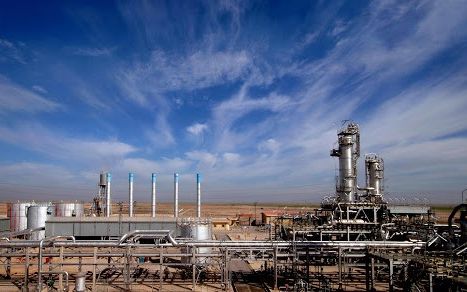IRGC-Affiliated Agency Blames US Democrats For Esfahan Protests

Iran’s IRGC-affiliated Fars news agency has blamed US Democrats for protests in Esfahan alleging that it is related to the upcoming resumption of nuclear talks.

Iran’s IRGC-affiliated Fars news agency has blamed US Democrats for protests in Esfahan alleging that it is related to the upcoming resumption of nuclear talks.
The hardliner media in Iran has tried to accuse provocateurs and paid mercenaries for protests in the country’s third largest city that began more than two weeks by farmers demanding water and turned into anti-government unrest after security forces attacked demonstrators on Thursday and Friday.
But Fars on Saturday took the allegations to a new level by accusing US Democrats of “once again” fomenting unrest to gain leverage days before talks in Vienna are due to start for the revival of the 2015 nuclear agreement, the JCPOA.
It is not clear why the Democrats are being accused of using an old tactic, except for large protests in 2009 during the Obama presidency that were triggered when Mahmoud Ahmadinejad was declared the winner of the presidential race and millions of people came out to the streets to challenge the hastily announced official results.
Following the 2009 protests, which the Obama administration did not vocally support, there were no other large protests in Iran until after Donald Trump’s election, when nationwide unrest broke out against economic hardship in late December 2017.

Anti-government protests continued overnight in Esfahan as security forces attacked demonstrators with a variety of weapons and reportedly arrested 120 people.
As authorities restricted internet access in Esfahan and other cities, videos on social media showed groups of protesters shouting, “Death to the dictator”, and slogans against Iran’s intervention in Syria, demanding attention to the country’s internal problems.
Anti-riot police remained in the streets in large numbers, trying to end the protests that began two weeks ago by farmers from regions around the city, demanding water for irrigating their parched fields.
An Iranian human rights group said its preliminary information indicates authorities have arrested 120 people.
Security forces used tear gas, batons, and shotguns firing “bird shots” at demonstrators that inflicted serious injuries. Images and reports from local sources show that three people might have been killed, but a final toll has not been confirmed by the government or human rights activists monitoring the situation.
Mohammad-Reza Mir-Heidari, Esfahan’s police chief confirmed that citizens were injured but he also insisted that security forces were also hurt by stone-throwing protesters. He threatened “to deal” with protesters.

Protests in Esfahan Friday continued into the evening with clashes between protesters who chanted anti-regime slogans and security forces who attacked them.
Protests started Friday morning in the dry bed of Zayandeh Roud where farmers had been protesting for over two weeks but spread to the other areas of the city after security forces drove them out.
Videos posted on social media Friday afternoon showed protesters angrily chanting slogans against Supreme Leader Ali Khamenei, clerical rule, and security forces in some instances, they clashed with them. "We are here to fight, fight us and we will fight you back," they chanted in one place while in another they shouted "Death to the Supreme Leader” and "Blessed be your soul O' King" referring to Mohammad Reza Shah Pahlavi who was deposed by the Islamic Revolution of 1979.
In two videos posted on social media, a woman is seen unconscious on the ground with blood on her face and in another a man is fallen on asphalt while the person recording the scene on video said he was shot dead. In another video three men are shown at a hospital emergency room with bloody bandaged heads, apparently hit with batons, while medical staff tend to them. Social media users also claim many were injured with birdshot fired from shotguns.
"It was the police who did this, don't go and claim later that they were thugs and hooligans," a wounded old man in one of the videos says. Authorities often refer to anti-government protesters as "thugs and hooligans".
The videos also show several riot police beating a protester with batons and kicking him, men and women with bloody heads and faces and an old man with multiple birdshot wounds on his back.
The regime is in crisis and this crisis is not limited to Esfahan and its water problem, Saeed Madani, social researcher in Tehran, told Iran International. Farmers in Esfahan protested peacefully in the most civil manner, they did not even take to the streets, instead they chose the dry riverbed and used their constitutional right to protest in the most logical way and were supported by a good number of other citizens also affected by water shortage, he added.
"The authorities showed some tolerance at first but sadly yesterday and today they showed their usual response, the same [violent] response as in Khuzestan and other places," Madani told Iran International.
From around 6:00 PM, there have been reports of mobile internet shutdown and slowing down of wi-fi internet to prevent videos of the protests being posted online. One video posted on Twitter shows drivers honking their horns repeatedly on the streets in protest after dark.
The state-run television (IRIB) showed a scene of the protests Friday morning where people chanted against the IRIB and called it a disgrace. The report said security forces had had to use tear gas to disperse protesters which it claimed were a small group. The report also insisted that farmers protesting water shortage had ended their protests Thursday and were not involved in Friday's protests.
The government's tolerance for civil and environmental protests is limited and they always resort to violence when protests reach a point when they fear the unrest could spread, Iran International's journalist and analyst Morteza Kazemian says. "It's incapable of a logical and professional response," he said.
Kazemian cited the remarks of the Friday prayer imam of Mashhad, Ahmad Alamolhoda, the father-in-law of President Ebrahim Raisi, as an example who said water shortage would not be solved by rallies and protests. "Rallies against god will not work. Rallies must be to pray for rain,", Alamolhoda, Khamenei's powerful representative in Khorasan-e Razavi Province said.
"How water resources should be managed is something the authorities have no answer for," Kazemian added.

Iran’s exiled Prince Reza Pahlavi has praised the “bravery” of the people of Esfahan who gathered to protest on Friday and were attacked by special riot police.
In a series of Tweets, the US-based heir to the Iranian throne, said the people in the city exhibited “bravery, unity, resistance and steadfastness in seeking justice.” He added that the unarmed residents of Esfahan and farmers who had come to the city faced brutality by “armed mercenaries of the Islamic Republic” and showed to what extent the regime is afraid of the nation.
People have been protesting lack of water for two weeks. The government first tolerated the protests, but this week they decided to use force against demonstrators. On Thursday, they attacked and burned a makeshift camp protesters had set up on the dry riverbed of the iconic Zayandeh Roud river and on Friday they cracked down on residents who came out to protest.
Prince Reza Pahlavi also urged unity among different regions on the issue of water scarcity. Critics have alleged that the government is trying to put one region against the other over who will get more water.
Drought and mismanagement by the government have led to a serious water crisis in Iran.

A prominent former lawmaker in Iran says officials and state-run media lied to the people about Covid-19, particularly in early 2020 when the pandemic began.
Heshmatollah Falahatpisheh, a former Foreign Policy and National Security Committee chief in the Iranian Parliament (Majles) told Didban Iran [Iran Monitor] news website on Thursday, that the Iranian state television's recent claim about having informed all government entities about the pandemic at its onset was not true.
In early 2020, Iranian officials including then-President Hassan Rouhani and Supreme Leader Ali Khamenei denied international media reports about the pandemic fearing that the news would dissuade the people from going to the polls to vote in the February 2020 parliamentary election. The state-run media also ridiculed international media and accused them of scaremongering. Supreme Leader Khamenei and several leading hardline clerics later blamed foreign countries including the United States for spreading the virus and scaring Iranians.
Falahatpisheh also charged that all Iranian officials who denied the spread of coronavirus to Iran during in that period knew about the pandemic and deliberately lied to the nation.
Meanwhile, Falahatpisheh said some Iranian airlines carried Chinese passengers to and from China from January to March 2020 when China's own airlines were grounded because of the pandemic. Many Iranian and international media outlets at the time reported that Mahan Air, an Iranian airline linked to the Revolutionary Guards (IRGC) was involved in airlifting Chinese passengers and used the same airlines for domestic flights in Iran, in a way, helping spread the virus.
Documenting one of those flights, Flight tracking website Flight Radar 24 reported on February 20, 2020 that Mahan Airlines, which is sanctioned by the US, flew from Beijing to Tehran (Flight W578) on the date and landed at 4:40 in the morning in the Imam Khomeini Airport in Tehran. Iran announced its first cases of coronavirus infections and deaths hours after the election on February 19.
Although Iranian officials said on January 31, 2020 that all flights had been stopped, Mahan Air continued flights to china but said under media pressure that it was not carrying Iranian passengers and that it was only airlifting Chinese passengers who were stranded in Turkey.
Falahatpisheh charged that some Iranian airlines acted as though they were companies of a Chinese colony.
Meanwhile, the former lawmaker lashed out at Iranian officials who imposed a high toll on the people by pushing for the development of homegrown Covid vaccines. He charged that those officials bluffed about a "national vaccine" and the people of Iran paid the price of those bluffs with their lives.
However, he did not mention that Ali Khamenei's support for the idea of national vaccines and his ban on the import of US and UK made vaccines in January led to tens of thousands of more deaths in Iran before the government was allowed to import foreign-made vaccines after hardline President Ebrahim Raisi took office in August.
Falahatpisheh blamed the officials' lies and greed for the lives lost in Iran in the absence of an effective vaccination effort until August.
He called on the parliament to launch an investigation into the mismanagement and errors of the officials during the pandemic.

Oil prices dived more than 5% on Friday as a new Covid-19 variant spooked investors and added to concerns that a supply surplus could swell in early 2022.
Oil fell with global equities markets on fears the variant, which Britain said scientists considered the most significant found to date, could restrict travel and dampen economic growth and fuel demand.
Investors were also watching China's response to the US release of millions of barrels of oil from strategic reserves in coordination with other large consuming nations, part of its bid to cool prices.
Such a release is likely to swell supplies in coming months, an OPEC source said.
Iranian production was also in focus, with indirect talks due to resume on Monday between Iran and the United States on reviving a 2015 nuclear deal that could lead to the lifting of U.S. sanctions on Iranian oil exports.
However, the failure of Iran and the International Atomic Energy Agency to reach even a modest agreement on monitoring of Tehran's nuclear facilities this week bodes poorly for next week's talks, Eurasia analyst Henry Rome said.
The forecasts cloud the outlook for a Dec. 2 meeting of OPEC and its allies, known as OPEC+, when the group will discuss whether to adjust its plan to increase output by 400,000 bpd in January and beyond.
Reporting by Reuters